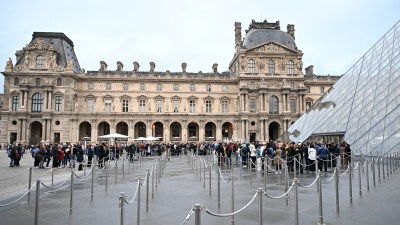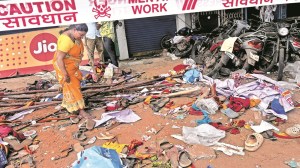Article 370 judgment: What was the Jammu and Kashmir constituent Assembly and what did it negotiate?
J&K had acceded to India in respect to only defence, foreign affairs, and communications; Parliament could make laws beyond them with the ‘concurrence of the Jammu and Kashmir Constituent Assembly’.
 A five-judge Constitution bench, presided by Chief Justice of India D Y Chandrachud, pronounced three judgments in pleas challenging the abrogation of Article 370, which gave special status to the erstwhile state of Jammu and Kashmir.
A five-judge Constitution bench, presided by Chief Justice of India D Y Chandrachud, pronounced three judgments in pleas challenging the abrogation of Article 370, which gave special status to the erstwhile state of Jammu and Kashmir.Upholding the abrogation of Article 370 on Monday, Chief Justice of India DY Chandrachud said the Article was a “temporary provision”.
“The power of the President to issue a proclamation that Article 370 ceases to operate subsists even after the constituent Assembly of Jammu and Kashmir ceased to exist in 1957…Holding that the President has no such power after the dissolution of the Constituent Assembly of J&K would lead to the freezing of the process of integration,” the CJI said.
What was the constituent Assembly of J&K?
J&K acceded to the Indian Union in October 1947, after signing the Instrument of Accession. In his book ‘Article 370: A Constitutional History of Jammu and Kashmir’, constitutional expert and commentator A G Noorani writes that J&K had acceded to India in respect to only defence, foreign affairs, and communications. Parliament could make laws beyond them with the ‘concurrence of the Jammu and Kashmir Constituent Assembly’.
He adds: “Negotiations were held on 15 and 16 May 1949 at Deputy PM Vallabhai Patel’s residence in New Delhi on Kashmir’s future set-up. Nehru and (the first Prime Minister or Sadar-i-Riyasat of J and K Sheikh) Abdullah were present. Foremost among the topics were the ‘framing of the Constitution for the state’ and the ‘subjects in respect of which the state should accede to the Union of India’. On the first, Nehru recorded in a letter to Abdullah that both Patel and he agreed that it was a matter for the state’s Constituent Assembly.”
The Constituent Assembly of India, tasked with framing the Indian Constitution, had, in October 1949, introduced draft Article 306A (which was later renumbered as Article 370). The Article was discussed for five months between May and October 1949. “Jammu and Kashmir was the only state in the Union of India which negotiated the terms of its membership with the Union,” writes Noorani.
Clause 370(3) reads: “Notwithstanding anything in the foregoing provisions of this Article, the President may, by public notification, declare that this Article shall cease to be operative or shall be operative only with such exceptions and modifications and from such date as he may specify.” The Clause 370 (3) also said that the recommendation of a Constituent Assembly of the state be necessary before the President issues such a notification.
Noorani writes further that on April 20, 1951, a proclamation was made for convening a Constituent Assembly of the state. “Two issues came to the fore. Nehru was eager to secure Kashmir’s ‘closer integration’ to India. The Sheikh was as eager to preserve its autonomy,” writes Noorani.
It was decided that the J&K Constituent Assembly would consist of representatives of the people, elected on the basis of adult franchise, and would help frame a constitution for the state.
For the purpose of election to the Constituent Assembly, the state was divided into territorial constituencies, each containing a population of 40,000, with each electing one member.
An article from the Constitution of India database, an initiative by the Centre for Law and Policy Research, Bangalore, notes that the elections for the same were held in August-September 1951. The National Conference led by Sheikh Abdullah swept them. All 75 members were from the party.
Similar to Indian Constituent Assembly
The Article adds that the J&K Constituent Assembly largely adopted procedures similar to the Indian Constituent Assembly, with smaller groups of Assembly members constituted into committees and tasked with producing draft Articles on specific themes. The reports of these committees containing draft Articles were presented to the plenary Assembly for debate and amendments. The Assembly then adopted or rejected the Articles via vote.
The J&K Constituent Assembly first met on October 31, 1951.
Noorani’s book notes that in their early sessions, the committees deliberated on whether the state would be based on the principles of democracy or constitutional monarchy (considering it was a princely state), and on a flag for the state.
Noorani quotes a white paper of the Government of J&K on the Delhi Agreement of 1952 entitled ‘India and Kashmir – Constitutional Aspect’. It noted, “The main functions which the Constituent Assembly was envisaged was the question of the accession of the state; retention or abolition of the Ruler as the Constitutional Head of the State; the question of framing a Constitution for the state, including the question of defining the Union sphere of jurisdiction over the state; and the question of awarding compensation to the landlords whose lands had been expropriated under the Big Landed Estates Abolition Act.”
On Article 370
On the nature of Article 370, Noorani quotes Abdullah’s statement on the Delhi agreement from a J&K Constituent Assembly debate dated August 11, 1952. “I would like to point out that the fact that Article 370 has been mentioned as a temporary provision in the Constitution does not mean that it is capable of abrogated, modified, or replaced unilaterally. In actual effect, the temporary nature of this Article arises merely from the fact that the power to finalise the constitutional relationship between the State and the Union of India has been specifically vested in the Jammu and Kashmir Constituent Assembly,” said Abdullah.
On August 9, 1953, the police arrested Sheikh Abdullah, and dismissed his government on the charge that he had lost the confidence of his Cabinet. Bakshi Ghulam Mohammed took over as Sadar-e-Riyasat in his place.
The Constitution of J&K was adopted in 1956.
Sheikh Abdullah spent most of his time in detention till his release in 1964, to a rapturous welcome.





- 01
- 02
- 03
- 04
- 05


























